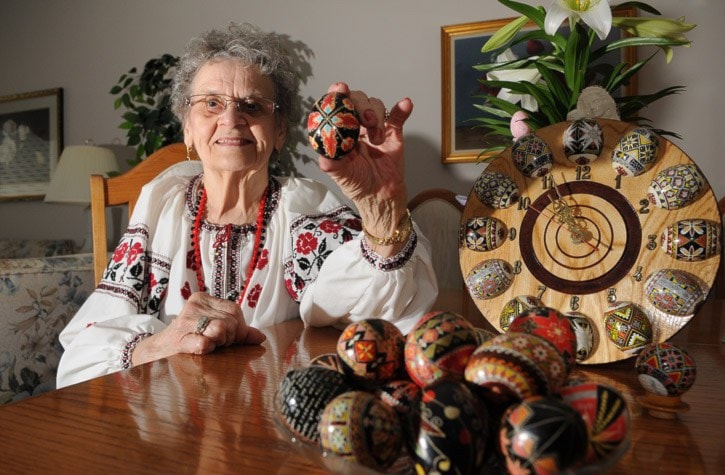Nellie Marchuk didn't have the hand for pysanky, but she did have the eye.
A "true" Ukrainian, the 88-year-old has held strong to her roots for all her years.
She has religiously prepared the traditional 12-course Ukrainian Christmas Eve feast; is a member of the Ukrainian Women's Association and the Fraser Valley Ukrainian Senior Citizen's Association; and every Easter she gets a basket filled with the evening's feast – ham, sausage, horseradish relish, babka and paska – blessed by the Ukrainian church.
In that basket is always a beautifully decorated Ukrainian egg.
"I love the colours," Marchuk said as she gently cradled an egg gifted to her from one of her students in 1947 that still has the dried yolk inside – when it wasn't required to blow out the contents.
The history of Ukrainian eggs, also known as pysanky, dates back more than 2,000 years when Ukrainians worshipped a sun god, and believed a great power was embodied in the egg. Every spring peasants decorated the eggs with nature symbols to celebrate and honour the sun before planting their crops.
With the rise of Christianity, the decorated eggs soon became Easter symbols, likening them to the tomb from which Jesus arose.
It's a tradition that continues strong today for Ukrainians, like Marchuk, around the globe.
Twenty five years ago, Marchuk first tried her hand at the unique art form.
"I figured I knew everything else Ukrainian, why shouldn't I learn how to write an Easter egg," she said. "We do not paint Easter eggs, we write, colour and decorate."
With a step-by-step guidebook, a metal stylus, called kistka, beeswax and coloured dye, it took Marchuk just a day to design her first pysanka.
The red, black and white dyed egg, which she still holds dear today, features a prominent rose, along with smaller poppy like flowers and geometric designs including squares and diamonds.
"It was the easiest to do as far as I was concerned," Marchuk whispered with a smile. "You've got to have a steady hand and an imagination to write Easter eggs – I am not artistic."
But she can spot art.
Even though Marchuk retired her kistka after just two eggs, she faithfully purchases a new egg every year at her church's annual Easter bake sale. Her vast collection features religious symbols like churches and stained glass windows; animals; birds, flowers; wheat and other such plants; and an assortment of geometrics – all with their own special meanings.
"I figured I can't make more, but I can buy them," she laughed.
